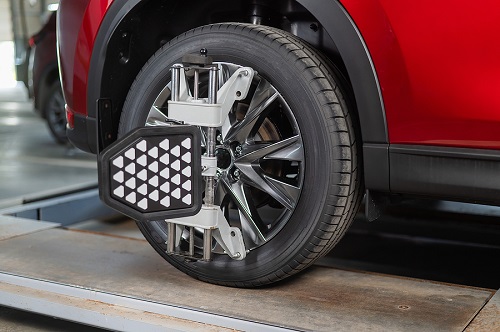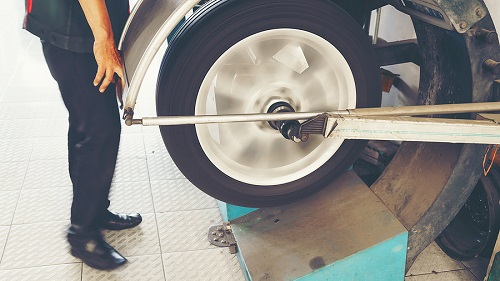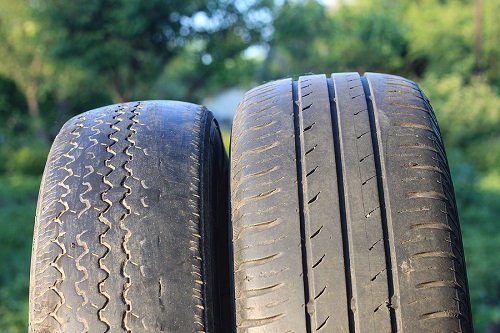It’s one of those motoring chores that many of us ignore, and many more of us simply don’t understand. So, what is tyre balancing and why do we need to do it?
Well, let’s start with the why, shall we? Take an average car’s wheel and tyre. As anyone who’s changed a tyre in the recent past knows, even supposedly lightweight alloy wheels and tyres are pretty hefty when you try to pick them up. Now imagine that same weight being spun round and round, over and over again as you drive.

At a steady 100km/h cruise, your wheels and tyres are going to be spinning at almost 1,000 revolutions per minute. Wind your minds back to basic Junior Cert science, and you might remember that spinning objects have a thing called the gyroscopic effect, which you might remember means that when you start something spinning, that thing will want to keep spinning in that direction, and it takes a lot of energy and force to get it to spin elsewhere.
Now let’s remember that those spinning things are your wheels and tyres, and they’re the only things keeping your car connected to the ground. Wouldn’t you want to make sure that they’re spinning as smoothly as possible? That’s where tyre balancing comes in.
It’s recommended that you should get your tyres rebalanced after every 10,000km (at least) or once a year.
But how do you actually balance a tyre?
There are two basic ways of balancing a tyre. There’s static balancing — this means that the wheel and tyre are placed on a simple spindle device, which will show if the wheel and tyre are naturally leaning in one direction. If this is the case, then small weights — just a fraction of an ounce — will be added to the wheel rim so that the weight is evenly distributed and there’s no lean in any direction.

There’s a more sophisticated method, and that’s dynamic balancing. In this, the wheel and tyre are placed onto a machine which spins them at speeds equivalent to driving at up to 100km/h, while sensors within the machine monitor how the wheel and tyre move, and whether the weight of the whole assembly is properly balanced. It can then be worked out precisely how much weight is needed to properly balance the wheel and tyre, and precisely where it needs to be added.
What happens if you don’t get your tyres balanced?
Well, there are a few possible outcomes. Generally the first consequence — and warning sign — of imbalanced tyres is uneven tyre wear. All things being equal, a tyre should achieve pretty well consistent wear across the width of the tread. If you notice that one or more of your tyres seems to be wearing unevenly, if for instance the outside edge seems to be more worn down than the inside, then the reason is most likely imbalanced tyres.

Not only is an unevenly worn tyre going to give you less control of your car, especially in the wet, it’s also going to have to be replaced sooner, as the extra wear on one side will bring you down below the legal minimum 1.6mm tread depth.
The next consequence and sign of tyre imbalance is a vibration, which will generally become more noticeable at higher speeds, such as when cruising on the motorway. This happens because the rotational force of each tyre isn’t pulling in the same direction as the others, so the car can begin to shake as if it’s driving over a bumpy road.
This is, clearly, annoying and it can be quite tiring on a longer journey. Worse still, that vibration can be damaging, and in extreme circumstances it could cause significant damage to your suspension, leading not only to an expensive repair, but potentially a loss of control and an accident.
Extra costs
Speaking of extra costs, imbalanced tyres can actually push your fuel consumption up — that’s because properly balanced tyres spin more easily, whereas the car’s engine has to work harder to get imbalanced tyres to spin at the speed at which you’re trying to cruise.
There’s an additional safety element if you’re driving a more modern car. Modern electronic safety systems — from traction control to stability control to emergency automatic braking — rely on the car’s performance being with a set of defined parameters to work properly. If your tyres are out of balance, then it’s quite possible that these electronic safety nets, which are designed to literally save your life and the lives of others in an emergency, may not be able to function correctly because the tyres are not quite rotating in the manner that they’re supposed to.
What can send a tyre out of balance?
Well, simply changing your tyres might imbalance them, as tyres can have different weights and construction from brand to brand, so it’s important to get newly-fitted tyres carefully balanced. Damage to the wheel rim, such as bashing it against a kerb, can also affect the balance, so make sure to get your tyres balanced if you’ve recently had an argument with a car park kerb.
So there you have it, an explanation on what tyre balancing is and why it's important. If you have any other questions, you can always get in touch!